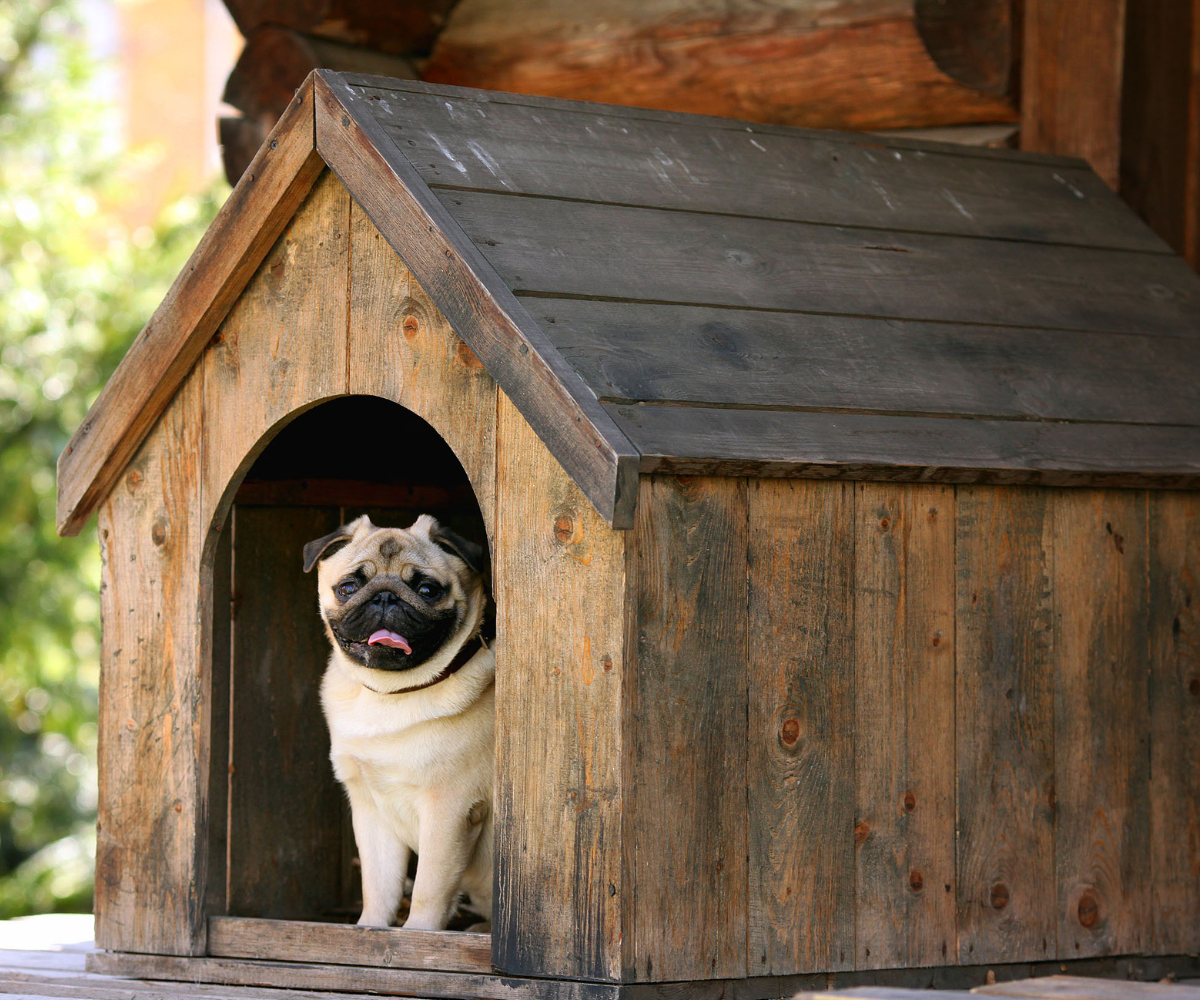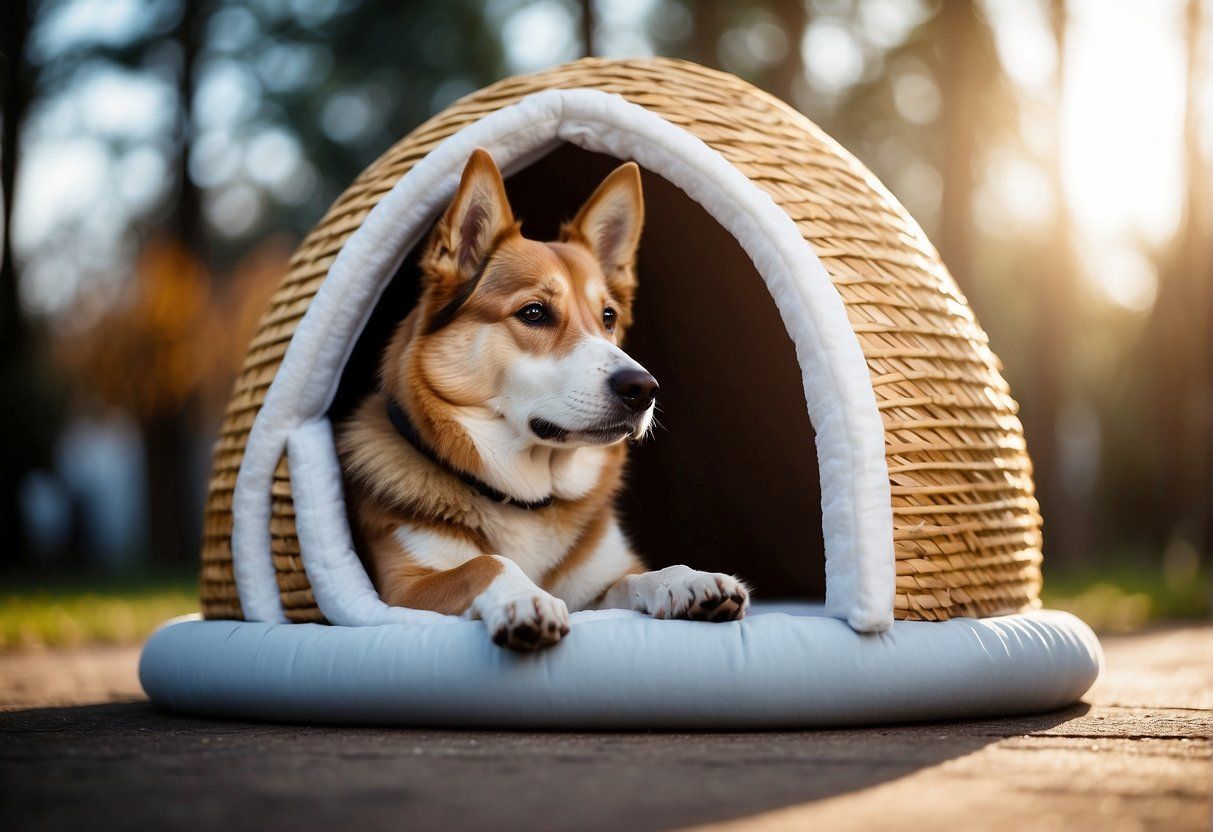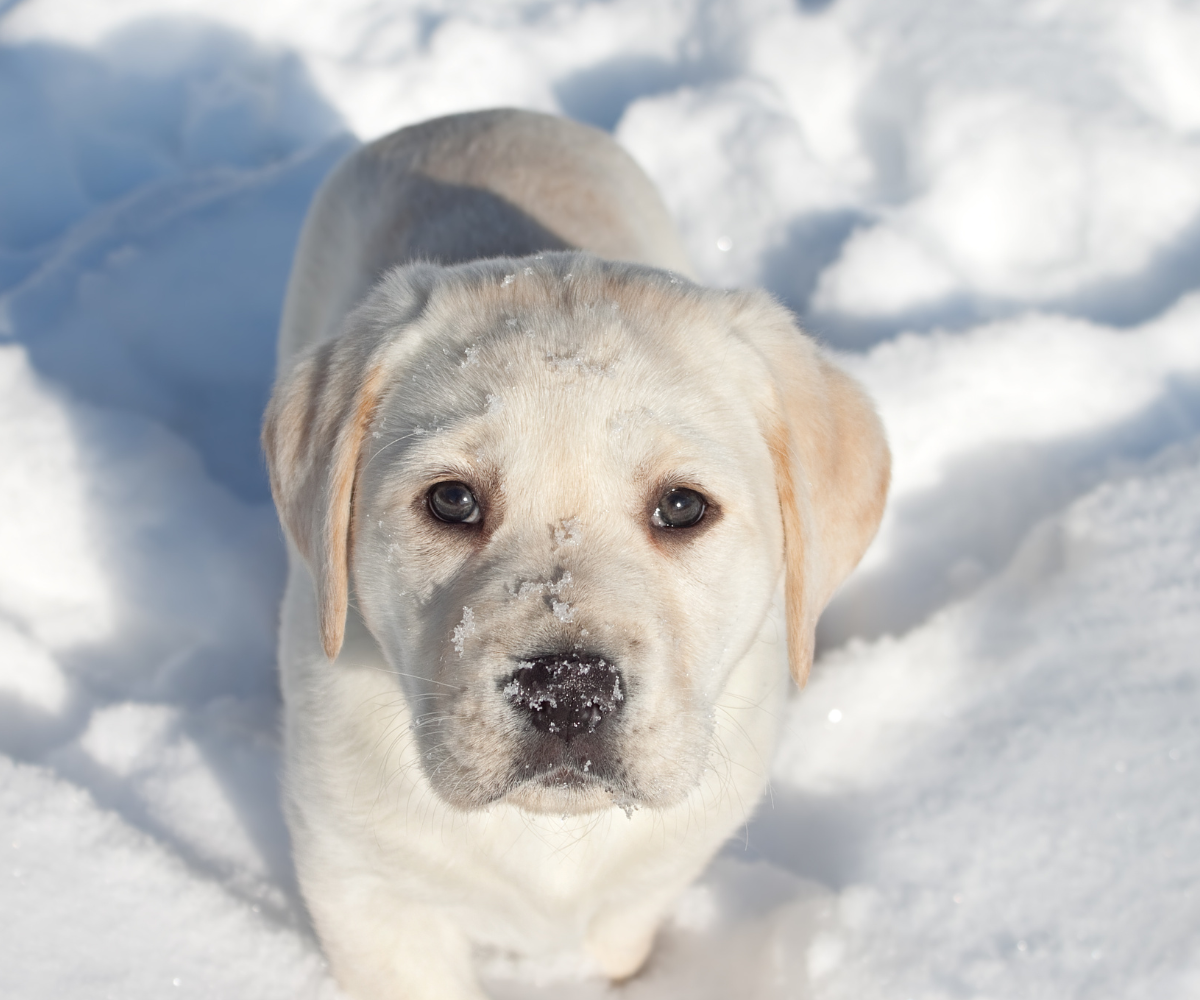The Best Ways to Insulate an Igloo Dog House
The Best Ways to Insulate an Igloo Dog House

Vet Reviewed

By: Sarah Hodgson
February 23, 2024
Table of Contents
Dog owners who live in areas with cold temperatures must ensure that their furry friends are warm and comfortable in their outdoor living spaces. One of the best options for outdoor dog houses is the igloo dog house. These dog houses are designed to keep dogs warm during cold weather conditions. However, it is essential to insulate the igloo dog house correctly to keep your dog safe and comfortable. In this article we'l learn exactly how to do that.
Let's dive in!
Key Takeaways
Insulating an igloo dog house is essential to keep your dog warm and comfortable during cold weather conditions.
Bedding materials such as straw can also provide insulation and keep your dog warm.
Weatherproofing sealants, fiberglass insulation, and non-toxic paint are some of the insulation options available.
What Is a Dog Igloo
A dog igloo is a type of dog house that is designed to provide insulation and protection against extreme weather conditions. It is shaped like an igloo, with a dome-shaped roof and a round entrance. The igloo shape helps to trap heat inside and keep the dog warm during cold weather.
- Dog igloos are made from a variety of materials, including plastic, wood, and foam. Plastic igloos are lightweight and easy to clean, while wooden igloos are more durable and provide better insulation. Foam igloos are the most insulated and can be customized to fit the size of the dog.
- Dog igloos come in different sizes, so it is important to choose the right size for your dog. The igloo should be big enough for the dog to stand up, turn around, and lie down comfortably. A dog igloo that is too big will not provide enough warmth, while a dog igloo that is too small will be uncomfortable for the dog.
In addition to providing insulation, a dog igloo should also be waterproof and windproof. This will help to keep the dog dry and warm during rainy or windy weather. Some dog igloos come with a built-in heating system, which can provide additional warmth during cold weather.
Overall, a dog igloo is a great investment for pet owners who want to provide their dogs with a warm and comfortable place to sleep. With the right size and insulation, a dog igloo can help to keep your dog warm and healthy during even the coldest winter months.
Importance of Insulation
Insulating an igloo dog house is crucial for keeping your furry friend warm and comfortable, especially during harsh weather conditions. Insulation helps to regulate the temperature inside the dog house, making it easier for your dog to maintain their body temperature and avoid hypothermia or heatstroke.
- One of the most important benefits of insulation is that it helps to keep your dog's body heat inside the house. This means that your dog can stay warm without having to rely on external sources of heat. Additionally, insulation helps to prevent the cold air from seeping into the dog house, which can cause a drop in temperature and make your dog uncomfortable.
- Insulation can also help to keep the dog house cool during hot weather. By preventing the heat from entering the house, insulation helps to maintain a comfortable temperature for your dog. This is especially important during the summer months when temperatures can soar.
- Another benefit of insulation is that it can help to reduce your energy bills. By keeping the temperature inside the dog house stable, you won't need to rely on external sources of heat or air conditioning to keep your dog comfortable. This can save you money on your energy bills in the long run.

Design Features of an Igloo Dog House
When it comes to keeping your furry friend warm and safe, an insulated dog house is essential. An igloo dog house is a popular choice among pet owners due to its unique design features that offer several benefits.
The Shape and Its Benefits
The igloo shape of the dog house is modeled after the traditional Inuit shelter and has several benefits. Firstly, the shape of the igloo dog house is aerodynamic and can withstand strong winds, making it a great option for those living in areas with extreme weather conditions. Secondly, the round shape of the dog house allows for better heat retention, keeping your dog warm and cozy even in the coldest of temperatures. Lastly, the igloo shape offers more space than a traditional dog house, allowing your pet to move around freely.
Material Considerations for Igloos
When it comes to choosing the right material for your igloo dog house, there are several options available. Plastic is a popular choice among manufacturers due to its durability and weather resistance. It is also lightweight and easy to clean. Fiberglass is another option that provides excellent insulation and is resistant to moisture and pests. However, it is more expensive than plastic and can be heavy. Other materials such as metal and wood can also be used, but they may not provide the same level of insulation as plastic or fiberglass.
The Different Ways to Insulate Your Dog’s Igloo House
When it comes to insulating your dog's igloo house, there are several options available. Each method has its own advantages and disadvantages, and the best choice will depend on your dog's needs and the climate in which you live. Here are some of the most effective ways to insulate your dog's igloo house.
1. Size Matters
The size of your dog's igloo house is an important factor to consider when insulating it. The house should be just large enough for your dog to stand, turn around, and lie down comfortably. A smaller house will retain heat better, as there is less space to heat up. Additionally, a larger house may be more difficult to insulate effectively.
2. Using Foam and Polystyrene
One effective way to insulate your dog's igloo house is to use foam or polystyrene panels. These materials can be cut to fit the walls, ceiling, and floor of the house, and then attached using glue, staples, or tacks. Foam and polystyrene are excellent insulators and will help keep your dog warm in cold weather.
3. Applying Reflective Foil and Bubble Wrap
Reflective foil and bubble wrap are two other effective insulation options. Reflective foil can be attached to the inside of the house, while bubble wrap can be attached to the outside. Both materials reflect heat back into the house, helping to keep your dog warm.
4. Natural Insulation Options
Natural insulation options include straw, hay, and wood shavings. These materials can be placed inside the house to provide insulation and warmth. However, they may not be as effective as other options, and they can be difficult to clean.
5. Bedding and Blankets
Another way to insulate your dog's igloo house is to provide warm bedding and blankets. These materials will help trap heat and keep your dog warm. However, they may need to be replaced frequently if they become wet or soiled.
6. Adding a Door Flap
Adding a door flap to your dog's igloo house can also help keep it warm. The flap will help prevent cold air from entering the house, while still allowing your dog to enter and exit easily.
7. Sealing Gaps and Drafts
Sealing any gaps or drafts in your dog's igloo house is essential for effective insulation. Use caulk or weatherstripping to seal any gaps around the door or windows, and make sure the roof is securely attached to the walls.
8. Installing Dog House Heaters
Finally, if you live in an extremely cold climate, you may want to consider installing a dog house heater. These heaters are designed specifically for use in dog houses and will provide your dog with a warm and comfortable place to sleep.
Overall, there are many effective ways to insulate your dog's igloo house. By choosing the right insulation materials and taking steps to prevent drafts and gaps, you can help keep your dog warm and comfortable in even the coldest weather.
Don't Overlook the Cold Ground
When it comes to insulating an igloo dog house, it's important not to overlook the cold ground. Even if the walls and roof of the dog house are well-insulated, the cold ground can still seep in and make your furry friend uncomfortable.
One way to address this issue is by raising the dog house onto a pallet or concrete blocks. This will create a buffer between the ground and the dog house, helping to keep the cold at bay.
Another option is to add a layer of insulation to the floor of the dog house. Styrofoam panels can be cut to fit the floor of the house, providing an extra layer of insulation. These panels can be covered with a durable material, such as wood, to protect them from wear and tear.
In addition to insulation, bedding can also help to keep your dog warm and comfortable. Straw is a great choice for bedding, as it provides excellent insulation and is also moisture-resistant. Fabric bedding, such as blankets and towels, should be avoided, especially in snowy terrains, as they can become wet and freeze, making your dog even colder.
By taking these steps to insulate the ground and floor of your igloo dog house, you can help ensure that your furry friend stays warm and comfortable, even in the coldest of temperatures.

If in Doubt, Don't Leave Him Out
When it comes to keeping your furry friend warm and comfortable during the colder months, it's essential to ensure that their igloo dog house is properly insulated. However, if you're unsure about whether your dog is warm enough, it's best not to leave them outside.
There are several ways to determine whether your dog is comfortable outside.
- One of the most important factors to consider is their breed. Some dog breeds, such as Huskies and Malamutes, are better suited to colder temperatures than others.
- Another factor to consider is your dog's age and health. Older dogs and those with health issues may struggle to regulate their body temperature, making them more susceptible to the cold.
If you're not sure whether your dog is warm enough, it's best to err on the side of caution and bring them inside. Alternatively, you can provide them with a heated dog bed or a warm blanket to help keep them comfortable.
Note
Remember, if your dog is showing signs of discomfort, such as shivering or lethargy, it's essential to take action immediately. This may involve bringing them inside, providing them with extra layers, or contacting your veterinarian for advice.
Key Special Considerations To Keep In Mind
When it comes to insulating an igloo dog house, there are some special considerations to keep in mind. These considerations will help ensure that your furry friend stays comfortable and safe, no matter the weather.
For Elderly and Arthritic Dogs
Elderly and arthritic dogs can benefit from extra insulation in their igloo dog house. As dogs age, their bodies become less efficient at regulating temperature, so they may feel the cold more acutely than younger dogs. Additionally, arthritis can cause joint pain and stiffness, which can be exacerbated by cold weather.
To help keep elderly and arthritic dogs comfortable, it's important to provide plenty of insulation in their igloo dog house. This can include adding extra bedding, such as blankets or a foam pad, as well as ensuring that the dog house is raised off the ground to prevent cold from seeping in from below.
If you have an elderly or arthritic dog, it's also a good idea to consult with your veterinarian. They can provide additional advice on how to keep your furry friend comfortable and healthy.
Adapting to Changing Seasons
Another important consideration when insulating an igloo dog house is adapting to changing seasons. While the insulation needs of your dog may be different in the summer than in the winter, it's important to ensure that they are comfortable year-round.
In the summer, it's important to provide plenty of ventilation to prevent the dog house from becoming too hot. This can include leaving the door open, adding a fan, or even using a cooling pad.
In the winter, extra insulation is key to keeping your dog warm and comfortable. This can include adding extra bedding, using straw or hay for insulation, and ensuring that the dog house is raised off the ground to prevent cold from seeping in from below.
By adapting to changing seasons and providing plenty of insulation, you can help ensure that your furry friend stays comfortable and safe year-round.
The Bottom Line
Insulating an igloo dog house is crucial to keep your furry friend warm and comfortable during the colder months. By using the right materials and techniques, you can ensure that your dog's house is well-insulated and protected from the elements.
By taking the time to ensure that your dog is warm and comfortable during the colder months, you can help to keep them healthy and happy all year round making you a happy dog owner as well.

Subscribe to Petfluence!
Get updates on the latest posts and more from Petfluence straight to your inbox.